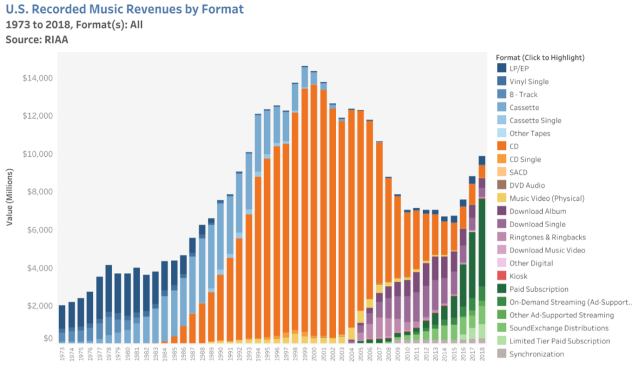Social Media
How Technology Transformed Pop Music
Blending talent with tech to redefine pop stardom.
Posted August 13, 2024 Reviewed by Abigail Fagan
Key points
- Technology reshaped music distribution, affecting listeners, bands, and the type of music produced.
- Trends moved toward faster chart success and more danceable, melancholic hits.
- Pop stars like Adam Levine have been aided by technology, creating a better connection with fans.
My interest in rock music never ventured much past the edge of the pop world. The Rolling Stones, Pink Floyd, or U2 never resonated with me on a personal level. Growing up I would hear them on the radio. So even though it was not my favorite music, I still heard these bands if they became popular.
As Y2K approached, the days of Queen and Journey were quickly fading. Then the radio brought me a new favorite rock band. Maroon 5 and its lead singer, Adam Levine, seemed to emerge out of nowhere. Their first album, Songs About Jane, was a modern blend of rock and Levine’s vocals were clearly identifiable.
How Pop Music Used to Shape Connections
The story of Maroon 5 is emblematic of the changes that have transformed the way in which audiences connect with music. The group began when four of its members — Adam Levine, Jesse Carmichael, Mickey Madden, and Ryan Dusick — formed the band called Kara’s Flowers in high school (Burns, 2013). An Indie manufacturer, Tim Allen led them to Reprise Records and producer Rob Cavallo. Their first album, The Fourth World, released in 1997, never made it up the charts.
Eventually, they reunited and began rehearsing with a new sound. James Diener, David Boxenbaum, and Ben Baker at Octone Records could feel the energy of the crowd during their live performances. Rather than turn a quick profit, Octone approached pop music differently by focusing on developing the band's nurturing approach that reflects the principles of gradual skill acquisition and mastery. Rebranded as Maroon 5, their music slowly went up the charts with their single “Harder to Breathe” peaking at number four a year after its release.
The Accelerated Pace of Pop Music and Its Impact
Research by Schneider and Gros (Schneider & Gros, 2019) has documented a broad change in consumer behavior. In the past, albums would rise slowly up the charts, eventually reach the top or close to the top post, and then slowly begin their descent. The old trajectory was similar to the one seen for Maroon 5’s first album, one that led to a band’s sound slowly being absorbed into a person’s musical experience.
The change in this rise to the top can be seen in the figure below.

What you can see is that in the past top albums did not start at the top of Billboard's top 100. In 1973, a future number one album would start on average at rank 45 and then move down to around the 20th place. In the late 1980s, we can see that trend dropped off a cliff. Top albums would enter the top 100 at the top and stay there.
As we move into the 2000s, you can see that virtually all top albums start at the top and drop off more quickly. This creates a more ephemeral connection to music, leading to more short-lived emotional experience.
Evolution in the Distribution of Pop Music
One of the questions that comes up is what might be the cause that leads to the increased speed with which top albums rise. The figure below from the Recording Industry Association of America shows is very revealing.
The main trend is from albums in dark blue, to cassettes in light blue during the early 1980s. CDs began to dominate sales in the middle of that decade and continue doing so as we transition to the 21st century. Y2K brought downloads which lasted a short while. By 2014, we see that music streaming overtakes all the other types of music formats.

The increase in streaming was also shadowed by a similar rise in the use of social media allowing people information about an album’s release to spread quickly among people. These technological trends changed the nature of pop music entirely (Interiano et al.). For the last 30 years, hits are likely to be sung by a female pop star, sadder and more danceable. The packing of music has altered the emotional experience of the pop music listener.
Emergence in Pop Music: A New Perspective
The story of Maroon 5 shows how quickly the music landscape and our experiences have evolved. Even with the release of their second album, It won’t be soon before long, creating a certain feel in myself and their fans.
As time went by, Maroon 5 began to blend in with the broader pop music trend, a shift without any specific cause. Faster chips, more memory, and the internet led to faster distribution. Social media came in and accelerated the process even more. Changes in pop music are also shed light on the ways that our minds process information. As humans, we are constantly adapting to new stimuli, integrating multiple influences to shape our experiences and identities. As a researcher, I find these “emergent” phenomena and their effects on our minds fascinating.
Levine and Maroon 5 came on the cusp of profound transformation in technology and culture. They came at a time of great transition. Their long gradual rise to the top eventually gave way to an acceleration in which music was distributed and the way in which fans experienced it. In short, it was not Adam vs. The Internet. Rather it is Adam combined with the internet. It might be aptly labeled the ADAMNET.
References
Burns, K. (2013). Maroon 5: Biography, Songs, and Lyrics. Kindle E-Book.
Interiano, M., Kazemi, K., Wang, L., Yang, J., Yu, Z., & Komarova, N. L. Musical trends and predictability of success in contemporary songs in and out of the top charts. Royal Society Open Science, 5(5), 171274. https://doi.org/10.1098/rsos.171274
Schneider, L., & Gros, C. (2019). Five decades of US, UK, German and Dutch music charts show that cultural processes are accelerating. Royal Society Open Science, 6(8), 190944. https://doi.org/doi:10.1098/rsos.190944




